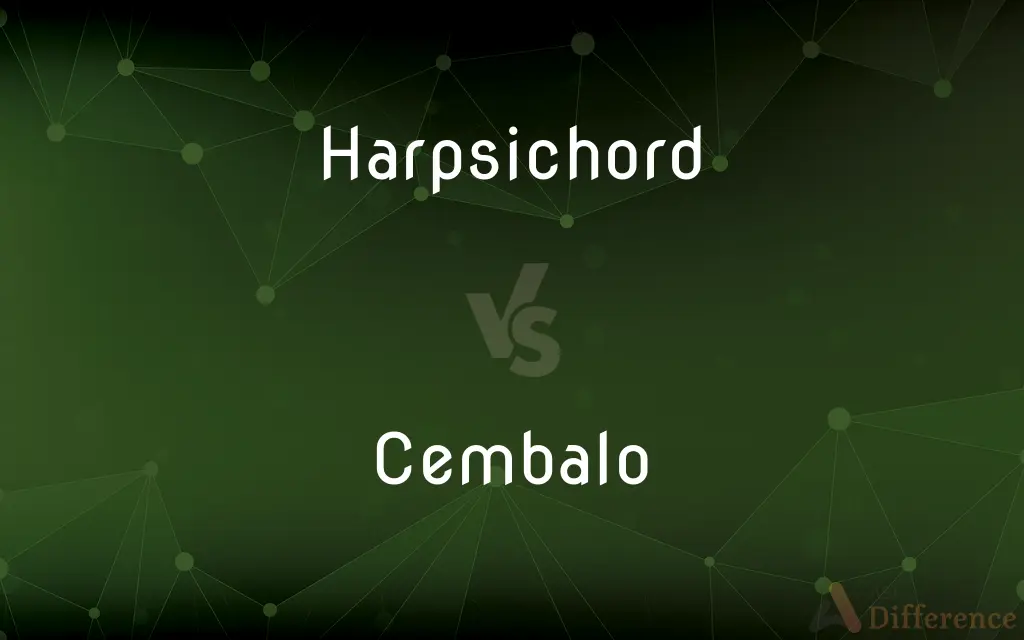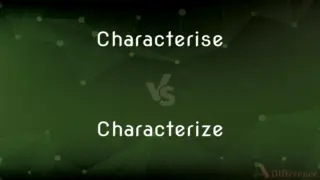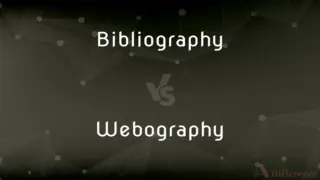Harpsichord vs. Cembalo — What's the Difference?
By Fiza Rafique & Maham Liaqat — Updated on March 22, 2024
Harpsichord and cembalo refer to the same musical instrument, known for its quilled keys that pluck strings, though "cembalo" is primarily used in Italian and some European contexts.

Difference Between Harpsichord and Cembalo
Table of Contents
ADVERTISEMENT
Key Differences
The harpsichord, a keyboard instrument, is characterized by its mechanism where the strings are plucked, not struck. This creates a distinct sound that is quite different from that of the piano, an instrument with which it is often compared. The term "harpsichord" is widely used in English-speaking countries and has become the general term to describe this instrument in international musicology.
Cembalo, on the other hand, is simply the Italian name for the harpsichord. The use of "cembalo" is common in Italian and can also be found in other European languages, reflecting the instrument's prominence in Baroque music, which heavily features the harpsichord. The choice between "harpsichord" and "cembalo" often depends on the linguistic or cultural context, rather than any significant difference in the instrument itself.
Both terms describe an instrument with a wide range of styles and sizes, including the small, portable virginals and larger instruments with two keyboards and multiple registers. Regardless of the name, the technique for playing and the intricate mechanism behind the sound production remain the same, emphasizing the unique timbre and expressiveness of the instrument.
Historically, the harpsichord (or cembalo) played a central role in European music from the Renaissance through the Baroque period. Its ability to produce a continuo part made it indispensable in ensemble and solo compositions. Despite the decline in popularity with the rise of the piano in the Classical period, the harpsichord saw a resurgence in the 20th century, particularly in the performance of early music.
The terminology can also reflect the musicological or historical context in which the instrument is discussed. For example, scholars and performers specializing in Italian Baroque music might prefer "cembalo" to emphasize the historical and cultural context of the repertoire. Conversely, "harpsichord" is a more universally understood term that encompasses the instrument's use across various European musical traditions.
ADVERTISEMENT
Comparison Chart
Name Origin
English term.
Italian term for the same instrument.
Usage
Predominantly in English-speaking countries.
Mainly in Italian and some European contexts.
Sound Production
Strings are plucked by quills.
Identical mechanism to the harpsichord.
Role in Music
Central in Renaissance and Baroque periods.
Same historical significance, especially in Italian repertoire.
Cultural Context
Used universally in discussions of Western music.
Often used to emphasize Italian or Baroque musicological contexts.
Compare with Definitions
Harpsichord
Has a range of designs, including double keyboards.
The museum's harpsichord features an elaborate decoration.
Cembalo
Italian term for the harpsichord, with the same sound mechanism.
Vivaldi wrote many pieces for the cembalo.
Harpsichord
Known for its distinct, metallic timbre.
The harpsichord's sound added a unique texture to the baroque ensemble.
Cembalo
Celebrated in early music performances today.
The festival's cembalo recital attracted enthusiasts of baroque music.
Harpsichord
Used extensively in Renaissance and Baroque music.
The harpsichord accompanied the singers in the opera.
Cembalo
Features in solo and continuo contexts.
Solo cembalo pieces highlight the instrument's expressive capacity.
Harpsichord
Experienced a revival in the 20th century.
Modern musicians explore the harpsichord's potential in contemporary music.
Cembalo
Integral to Italian and European baroque music.
The cembalo's role in early music ensembles is pivotal.
Harpsichord
A keyboard musical instrument, strings plucked by quills.
Bach's compositions for the harpsichord remain timeless.
Cembalo
Subject of historical and musicological research.
Scholars examine the cembalo's evolution in instrument making.
Harpsichord
A harpsichord (Italian: clavicembalo, French: clavecin, German: Cembalo, Spanish: clavecín, Portuguese: cravo, Dutch: klavecimbel) is a musical instrument played by means of a keyboard. This activates a row of levers that turn a trigger mechanism that plucks one or more strings with a small plectrum made from quill or plastic.
Cembalo
A harpsichord.
Harpsichord
A keyboard instrument with horizontal strings which run perpendicular to the keyboard in a long tapering case, and are plucked by points of quill, leather, or plastic operated by depressing the keys. It is used chiefly in European classical music of the 16th to 18th centuries.
Cembalo
(musical instruments) A harpsichord.
Harpsichord
A keyboard instrument whose strings are plucked by means of quills or plectrums.
Cembalo
An old name for the harpsichord.
Harpsichord
(musical instruments) A musical instrument with a keyboard that produces sound through a mechanical process. When the performer presses a key, a corresponding plectrum plucks a tuned string. Harpsichords originated in late medieval Europe and is one of the most important instruments used to perform Baroque music.
Cembalo
A clavier with strings that are plucked by plectra mounted on pivots
Harpsichord
A harp-shaped instrument of music set horizontally on legs, like the grand piano, with strings of wire, played by the fingers, by means of keys provided with quills, instead of hammers, for striking the strings. It is now superseded by the piano.
Harpsichord
A clavier with strings that are plucked by plectra mounted on pivots
Common Curiosities
Why did the harpsichord fall out of favor?
The rise of the piano, which offered greater dynamic range and expressive capabilities, led to the decline in the harpsichord's popularity.
Is the cembalo used in modern music?
While less common, some contemporary composers and musicians incorporate the cembalo into their works for its unique sound.
Can both terms be used interchangeably in music?
In general musicological discussions, yes, but specific contexts might prefer one term over the other for clarity or tradition.
Has the harpsichord (or cembalo) seen a resurgence?
Yes, there has been a significant revival in interest, particularly in the performance of Baroque and Renaissance music.
What is the range of a typical harpsichord?
The range varies by model and historical period, but most harpsichords span about five octaves.
What are the main components of a harpsichord?
The main components include the keyboard, strings, jacks with plectra (usually quills), and the case which resonates the sound.
Why are there two names for the same instrument?
"Harpsichord" is the English term, while "cembalo" is Italian, reflecting linguistic differences in musical terminology.
What is a continuo part?
The continuo part in Baroque music is a bass line that provides harmonic support, often played by a harpsichord or cembalo and a bass instrument.
Are harpsichord and cembalo the same instrument?
Yes, they refer to the same instrument; the difference is mainly in the term used based on language and context.
How are harpsichords tuned?
Tuning a harpsichord involves adjusting the tension of each string to the correct pitch, similar to other stringed instruments but often with historical temperaments.
What makes the harpsichord different from the piano?
The harpsichord plucks strings with quills, while the piano strikes them with hammers, leading to distinct sound qualities.
Where can one see a harpsichord or cembalo today?
Many museums, universities, and private collectors hold harpsichords, and they are also used in performances of early music.
Can anyone learn to play the harpsichord or cembalo?
Yes, with practice and musical training, anyone interested can learn to play, though mastering its unique technique and repertoire may require specialized instruction.
How does the mechanism of a harpsichord work?
When a key is pressed, a mechanism called a jack rises, allowing a quill to pluck the string and produce a sound.
Share Your Discovery

Previous Comparison
Characterise vs. Characterize
Next Comparison
Bibliography vs. WebographyAuthor Spotlight
Written by
Fiza RafiqueFiza Rafique is a skilled content writer at AskDifference.com, where she meticulously refines and enhances written pieces. Drawing from her vast editorial expertise, Fiza ensures clarity, accuracy, and precision in every article. Passionate about language, she continually seeks to elevate the quality of content for readers worldwide.
Co-written by
Maham Liaqat















































